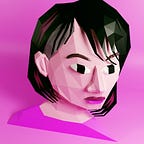Starting Summer 2021, I began my progress on developing my Master’s thesis at OCAD University as part of the IAMD program. My methodologies include research creation — allowing my making practices to help inform my thinking processes and creative auto-ethnography. I am interested in using game engines, 3D modeling software, and possibly VR technology in the creation of this piece to investigate my identity as a person of Mainland Chinese diaspora. This blog post documents my progress from 06.14.21 to 06.26.21.
The following is a list of personal goals I would like to achieve:
+ Improving my 3D modeling skills in Blender
+ Become familiar and more confident with Web XR, VR/AR tools
+ Gaining proficiency in game engines such as Unity and Unreal Engine as well as learning some basic coding and programming skills
I first began my exploration and experimentation progress by trying out different VR drawing tools and software on my Oculus Quest 2 headset. This included trying out apps such as Tilt Brush, SculptVR, and Quill. I also contemplated the idea of possibly creating a web VR piece using A-Frame. However, after completing these initial exercises, I landed upon deciding to use a combination of Unity and Blender for the creation of this thesis, both of which are what I have become the most familiar with using (albeit, still at a beginner level) when working in 3D.
I had spent last year learning how to use the Blender program. While jumping back into it this summer, I decided the best way would be to work from real life and looked towards referencing the houseplants within my home. I felt this was the best way of re-familiarizing myself with the program’s tools.
Recreating my houseplants in 3D led to the idea of recreating actual rooms and spaces within my own home, which have become all too familiar and intimate to me after spending 99% of my time here during the pandemic. I thought it would be a cool idea to turn my own life into a ‘video game’, creating a digital version of the 3 spaces that are the most personal to me — the bedroom, washroom, and studio office.
While being separated from friends and family during COVID-19, I believe there is a strong collective desire felt across the world to travel once again. Speaking from a personal perspective, I would desperately love to see my family in China again and visit my grandmother’s house in Shanghai. I have fond memories of visiting this house at numerous stages in life. My grandmother’s home in China and my home in Canada have been the two major formative spaces that have defined my identity.
For my thesis, I would like to take this idea of the ‘two homes’ and collapse them together into one space as an interactive VR piece. As someone who identifies with being a Chinese diaspora, this idea of ‘home’ is one that we often question throughout our lives. Within the game experience, as the player opens a doorway from my home in Canada, it will directly lead into the front courtyard of my grandmother’s house in China and the house itself, and loop back to my house in Canada once again. As the player walks through each ‘loop’ of the level, they will experience something new within the environment, such as subtle changes to the scenery or other interactions. The inspiration for this was from the famous horror game demo for Silent Hills called P.T, created by Hideo Kojima and Guillermo del Toro.
After deciding on a particular focus for my thesis creation, I began familiarizing myself with Unity’s interface. The following are screencaps of my learning progress on how to create objects and apply my own textures to them.
My primary advisor on my thesis project — Emma Westecott, advised that I commence building out the level in Unity as soon as possible and start importing models to test them out within the engine. During this process, I learned the concept of video game design called ‘greyboxing’ — creating a rough prototype of the level directly within the game engine, essentially a sketch of what the design layout will look like that is ready to be playtested at any moment. Greyboxing allows for the game level to be mapped out right away, making the development progress more efficient and helping to determine the scale of each object more easily. The tool I used for this was a Unity plugin called ProBuilder.
This first iteration of my greybox progress shows my living space layout, recreating my bedroom, washroom, and studio office space. The left side of the map is left open to start building out the level that will connect to my grandmother’s house in Shanghai.
Some questions raised after my first greyboxing experiments:
+ How accurate should I stay with recreating my living space in real life?
+ Will the 3D style of the models adhere to realistic looking materials and textures? Or will there be more of an abstracted stylistic look that involves more of my 2D illustration practice?
+ Will I place objects in the 3D space that actually don’t exist in the space in real life? How far-fetched can these objects be?
For me personally, I believe there can be some free agency in deciding to place a doorway in a wall that doesn’t exist in real life if it is meant to help improve the player’s experience of walking through the level. I think if it is able to provide a more seamless ‘looping’ sensation, then I am willing to let go of aiming for a 100% accurate representation of what these spaces look like in real life and can draw from the actual environments as more of a loose inspiration for the piece.
— MDes Thesis, IAMD Program at OCAD University.
Primary Advisor: Emma Westecott.
